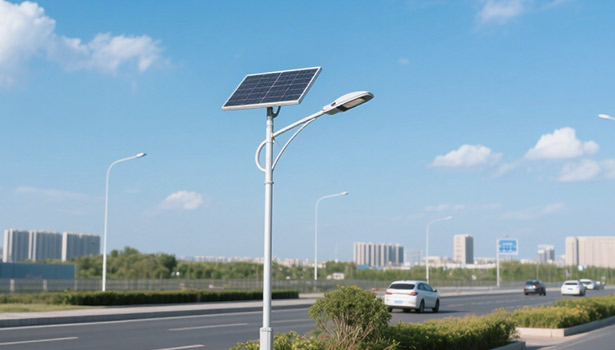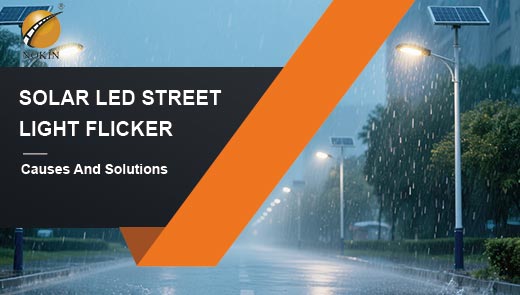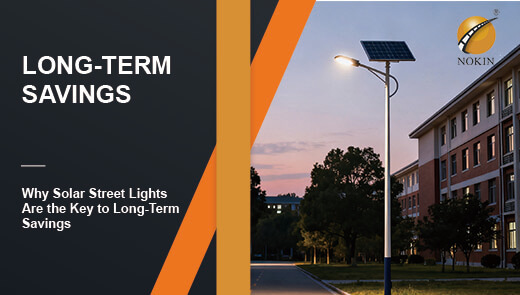Everything You Need to Know About Solar Street Light Batteries
The Connection Between Solar Street Lights and Solar Batteries
Today, global awareness of the importance and demand for renewable energy has increased significantly compared to the past. There are two key reasons behind this shift in thinking: first, the urgent need for environmental protection; second, the desire to reduce the rising costs of other available energy sources on the market. Over the past decade, the solar energy market has grown rapidly, with solar energy being recognized as one of the most readily available and in-demand free natural energy sources.
In recent years, it has seen widespread application in both commercial and residential settings. Solar batteries have become a wise investment choice for solar energy storage, as without them, it would be impossible to store the energy generated by solar systems for future use. For solar street lights, if they are grid-connected, the absence of solar batteries means there is no backup power source; if they are off-grid, the absence of batteries renders them completely inoperable. Therefore, solar batteries are a critical component for the successful operation of solar street light systems.

What are the Best Battery Types for Solar Street Lights?
Nickel-Cadmium Battery
Nickel-cadmium batteries use nickel-oxide electrodes on the anode and cadmium on the cathode, offering durability, high-temperature resistance, and minimal maintenance requirements. These batteries have been widely used in civilian and military aviation and are also popular in solar applications. They are an excellent choice for street lights in remote areas due to their high reliability and low maintenance needs. They are cheaper than lithium-ion batteries, can discharge to 60% depth of discharge (DOD), and provide 2,500 cycles, making them highly suitable for solar applications.
Lead-Acid Battery
Lead-acid batteries have been the mainstream choice for years due to their durability and low cost. The cathode is made of lead oxide, and the anode is metallic lead, both immersed in sulfuric acid electrolyte. However, despite their low cost, lead-acid batteries require regular maintenance and are not recommended for underground installation in solar street lights. In terms of discharge depth, they can provide 500 cycles at 50% DOD and 1,200 cycles at 30% DOD. AGM and gel batteries are the most commonly used lead-acid battery types in solar street lights.
Lithium-Ion Battery
Lithium-ion batteries are one of the most popular batteries for solar street lights, though they are also the most expensive. They use a lithium metal oxide cathode and a lithium carbon anode, immersed in a lithium salt electrolyte. Due to their high energy density, they can achieve a large capacity in a compact design, making them highly favored. These batteries can discharge to 80% DOD and provide 2,000–3,000 cycles for street lights.
Lithium Iron Phosphate Battery
Lithium iron phosphate batteries are another excellent lithium battery technology, offering a relatively lower cost. They also feature high energy density, can discharge to 80% DOD, and provide approximately 4,500 cycles. These batteries consist of a graphite anode and a lithium iron phosphate cathode, immersed in a lithium salt electrolyte. Due to their lower cost compared to lithium-ion batteries, maintenance-free operation, and high energy density, they have become the preferred lithium technology for solar street lights.
Flow Batteries
Flow redox batteries are unique, containing two electrolytes separated by a membrane. One half-cell contains the anode and the first electrolyte, while the other contains the cathode and the second electrolyte. The electrolyte pairs typically consist of vanadium/vanadium (in different states), iron/chromium, or zinc/bromine. This is an emerging technology that has not yet been widely adopted in the street light or solar industry. However, flow batteries have a higher cycle life than most batteries, can operate at low temperatures, and are easily scalable to accommodate most applications.

Key Considerations When Selecting a Battery for Solar Street Lights
Capacity and Size
Capacity refers to the total strength of the maximum amount of electricity or energy that a solar battery can store on a daily basis, measured in kilowatts or watts. When making a selection, it is essential to consider the local duration of sunlight, the power of the street lights, and the duration of nighttime illumination to determine the appropriate capacity. For example, in regions with shorter sunlight hours, a battery with a larger capacity should be selected to ensure the street light can operate normally during consecutive rainy days.
Regarding size, installation space constraints must be considered. For instance, some roadside lamp posts have limited internal space, so a battery of appropriate size must be chosen to avoid installation issues that could affect usage. Additionally, size impacts the battery's heat dissipation performance; both overly large or small sizes may adversely affect the battery's lifespan.
Depth of Discharge (DoD)
The depth of discharge refers to the level of battery capacity utilization. The higher the depth of discharge, the greater the usable capacity from the battery. Generally, the depth of discharge should be at least 40% or higher to achieve efficient power storage. However, the optimal depth of discharge varies among different battery types. For example, lead-acid batteries can have their lifespan significantly reduced if they are frequently deeply discharged, so their discharge depth must be controlled during use; lithium-ion batteries and lithium iron phosphate batteries, on the other hand, can withstand higher discharge depths and utilize battery capacity more fully. When selecting batteries, it is important to consider the discharge depth based on the battery type and actual power requirements to balance battery efficiency and lifespan.
Round-Trip Efficiency
Round-trip efficiency refers to the ratio of the energy used for charging the battery to the available energy used for discharging the load. The higher the round-trip efficiency, the more economical it is, so batteries with a round-trip efficiency of around 80% should be selected. A higher round-trip efficiency means that the battery has lower energy loss during charging and discharging, enabling more effective utilization of the energy generated by solar power.
In practical applications, round-trip efficiency is influenced by factors such as battery operating temperature and charge/discharge rates. For example, in low-temperature environments, the round-trip efficiency of some batteries may decrease. Therefore, when selecting batteries for cold regions, it is important to pay special attention to their round-trip efficiency performance at low temperatures to ensure efficient energy utilization.
Power Rating and Voltage
The power rating of a battery is related to the watts (W) of power it can provide in a single charge, determining how many and what types of devices it can power simultaneously. Solar street lights typically require a certain amount of power to maintain illumination, so the battery's power rating must meet the street light's power requirements; otherwise, it may result in insufficient brightness or failure to start normally.
Additionally, the voltage of the solar cell system must be considered to ensure compatibility with the solar street light's requirements. If the voltage does not match, additional equipment may be needed for voltage conversion, which not only increases costs but may also cause energy loss. Therefore, when selecting a battery, ensure that its power rating and voltage align with the solar street light's specifications.
Safety and Environmental Impacts
The selected solar battery should have environmentally friendly characteristics, low toxicity, and minimal environmental harm. The safest battery type should be chosen to ensure environmental friendliness. Some batteries contain toxic heavy metals such as lead and cadmium, such as lead-acid batteries and nickel-cadmium batteries. If not properly handled during production, use, or recycling, they can cause severe pollution to soil, water sources, and other environments.
Lithium-ion batteries and lithium iron phosphate batteries are relatively more environmentally friendly, but safety precautions must still be taken during use to prevent fires or other accidents caused by overcharging or short circuits. Additionally, the recycling and disposal system for batteries should be considered, and battery types that are easy to recycle and have minimal environmental impact should be selected.

Battery Lifespan and Warranty
Typically, battery performance degrades gradually over time, but a warranty ensures that the battery maintains good performance and retains a certain capacity over the years. Therefore, it is advisable to choose solar battery types with longer lifespans and higher cycle counts. Battery lifespan is influenced by various factors, such as charge/discharge cycles, operating temperature, and maintenance conditions. Generally, the higher the cycle count, the longer the battery's lifespan.
When purchasing batteries, pay attention to the warranty period and terms provided by the manufacturer, and clarify the handling procedures for performance degradation or malfunctions during the warranty period. Choosing batteries with a longer warranty period can help reduce potential risks and costs in the long run.
Thermal Runaway
Thermal runaway occurs when rising temperatures release energy that further escalates temperatures, often leading to battery damage or even fires. This factor must be considered when selecting solar batteries to prevent future hazards or damage. Different battery types have varying risks of thermal runaway, with lithium-ion batteries posing a relatively higher risk, especially in high-temperature environments or when subjected to external impacts.
Therefore, when selecting lithium-ion batteries, it is important to choose products with good heat dissipation design and over-temperature protection features. Lead-acid batteries and lithium iron phosphate batteries have relatively lower risks of thermal runaway, but the impact of temperature on their performance and safety should not be overlooked. Proper ventilation and heat dissipation conditions must be ensured during installation and use.
Price
Avoid selecting solar batteries that exceed your budget or incur excessive maintenance and repair costs in the future. Do not compromise on quality or capacity in pursuit of lower prices. Instead, choose batteries that meet your standards while staying within your budget. Some higher-priced batteries, such as lithium iron phosphate batteries, although requiring a larger initial investment, offer longer service life and lower maintenance costs, potentially making them more economical in the long run. Therefore, conduct a comprehensive cost analysis to select the battery with the best cost-effectiveness.
What’s the best Solar Battery for Solar Street Lights?
Over the past few decades, lead-acid batteries have been the preferred choice for solar-related systems due to their low cost and mature technology, capable of meeting basic energy storage needs. However, lithium iron phosphate batteries have emerged as the ideal choice for solar street lights due to their numerous advantages.
Lithium iron phosphate batteries have high energy density, allowing them to store more electricity in a smaller volume, thereby saving installation space; they can discharge up to 80% of their capacity, ensuring stable and prolonged lighting for street lights; they have a cycle life of approximately 4,500 cycles, significantly outlasting lead-acid batteries and reducing replacement frequency and costs; they require no regular maintenance, lowering post-installation workload and expenses; they offer excellent safety, with low risk of thermal runaway, and cause minimal environmental pollution.

Of course, flexible choices can be made for special scenarios. In remote areas where cost sensitivity is a concern, nickel-cadmium batteries are reliable, require minimal maintenance, and are moderately priced; for projects with extremely high performance requirements and sufficient budgets, lithium-ion batteries can be considered, but their higher cost limits their application.
Tips for Extending Battery Life in Solar Lights
Clean Solar Panels Regularly
Dirt and debris can reduce the efficiency of solar panels, leading to poor battery charging performance. Regularly cleaning the panels ensures they capture the maximum amount of sunlight, thereby providing sufficient power to the battery. Generally, cleaning once a month is appropriate. In dusty, rainy, or foggy regions, the cleaning frequency can be increased as needed. Additionally, inspect the panels for damage such as cracks or deformation, and promptly repair or replace them if issues are found to ensure the panels function normally.
Use High-Quality Batteries
Investing in high-quality, high-capacity batteries can help solar lights maintain optimal performance while reducing the frequency of battery replacements, making it more cost-effective in the long run. High-quality batteries offer greater assurance in terms of material selection and manufacturing processes, providing superior charge/discharge performance, cycle life, and safety. Low-quality batteries not only have unstable performance and a short service life but may also pose safety risks, jeopardizing the normal operation of solar street lights.
Replace Batteries Annually
Even with proper maintenance, the capacity of rechargeable batteries will gradually decrease over time. Replacing batteries annually helps maintain the optimal performance of solar lights. When replacing batteries, select ones that match the original model and specifications to ensure compatibility with the solar street light system. Disposed batteries should be properly handled and recycled in accordance with environmental regulations to prevent pollution.
The selection and maintenance of solar street light batteries directly impact the stable operation and cost control of the system. Considering the characteristics of various battery types, lithium iron phosphate batteries stand out as the preferred choice for most applications due to their comprehensive advantages. However, when selecting the most suitable product, factors such as capacity and safety must be carefully evaluated based on actual requirements. Regular maintenance of batteries can further extend their lifespan. With ongoing technological advancements, solar street light batteries will become more efficient and environmentally friendly, continuing to support green lighting initiatives. Selecting and utilizing the right batteries is a wise decision that balances current needs with long-term development goals.




